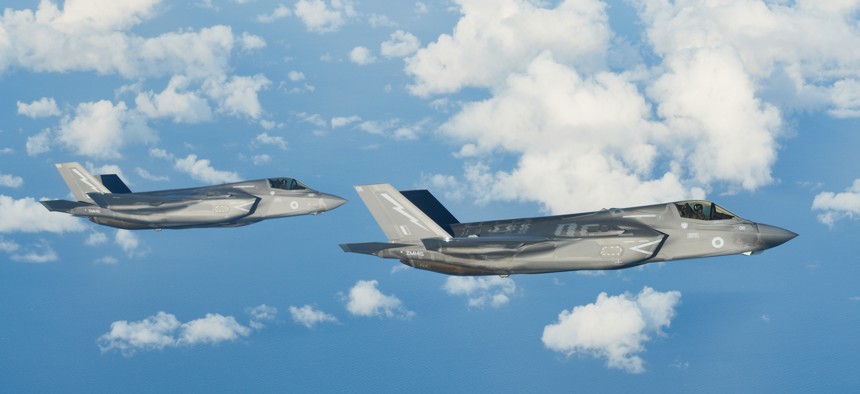
Getty Images
UK ‘Absolutely’ Will Buy More F-35s, Procurement Minister Says
But Jeremy Quin declined to say whether the 138-jet goal remains unchanged.
The United Kingdom plans to order more F-35 Joint Strike Fighters by 2025, a top Defence Ministry official said.
Jeremy Quin, the minister for defense procurement, said the UK would be adding to the 48 jets it has already purchased from Lockheed Martin.
“By 2025, we will be placing orders—I’m absolutely confident—for more of them,” Quin said during an interview Tuesday.
But Quin declined to say whether Britain’s original plan to buy a total of 138 jets remains unchanged. The Defense Ministry’s new defense strategy is similarly mum on the question.
The U.S. Air Force is considering trimming its own purchases of the F-35A variant; its current 1,763-jet plan was laid out in 1997. Top service leaders have recently declared the F-35A the cornerstone of its future combat fleet, but some generals are calling for earlier-than-planned development of a new generation of warplanes.
“I’ve seen the debate going on in the States. We think [the] F-35 is great,” Quin said. “We want more of them, but we’re also aware of getting that right balance between fighters and drones, etc. so of course we’ll be keeping under review exactly what the right numbers are, but it will definitely be more F-35s on order for use by the Royal Navy and RAF.”
The United Kingdom’s projected fleet of 138 jets is the third-largest of any nation, behind only Japan’s 147 aircraft and the United States’ tri-service fleet of more than 2,400.
The U.K. is using the F-35B—the short-takeoff and vertical landing version of the jet flown by the U.S. Marine Corps—to fly from its two new Queen Elizabeth-class aircraft carriers. The HMS Queen Elizabeth is scheduled to deploy to the Indo-Pacific region later this year with a U.S. Marine Corps F-35 squadron.
“The more we as allies can know that there is interoperability to support each other in the worst kind of scenarios, the more secure we should all feel,” Quin said.
Meanwhile, the U.K. military’s top procurement official touted work on the Tempest Future Combat Air System, a new-generation warplane under development.
“I think we all have similar mindsets that the future of combat air is going to be very, very different and we all need to be putting proper investment into it,” Quin said. “Look, over a period of time, potential adversaries have upped their game in terms of air combat.”
Quin was referencing advanced combat jets being developed by China and Russia.
The new U.K. defense strategy calls for boosting Tempest funding by nearly $3 billion. U.K. companies are also making their own investment in technology being considered for the new-generation warplanes, Quin said.
“This won’t just be a plane, it is a system,” he said. “We are very open minded as to how that develops — and the wingman flying alongside it — to make certain we have the technology that we’ll be able to deliver a punch in the future.”
BAE Systems, Rolls-Royce, Leonardo and MBDA are among the “Team Tempest” companies working on the new warplane, which is envisioned to replace the Royal Air Force’s Eurofighter Typhoons beginning in the mid-2030s.
Quin said there “has to be” opportunity for collaboration on these next-generation systems.
“I think all of us are at early stages on these programs, but interoperability is … invaluable,” Quin said. “Will there be opportunities, I’m sure these things will develop. I’m sure opportunities will emerge. But it’s no bad thing to have us all working hard to ensure that we are harnessing the potential of these technologies and to make certain we are covering all bases.”



